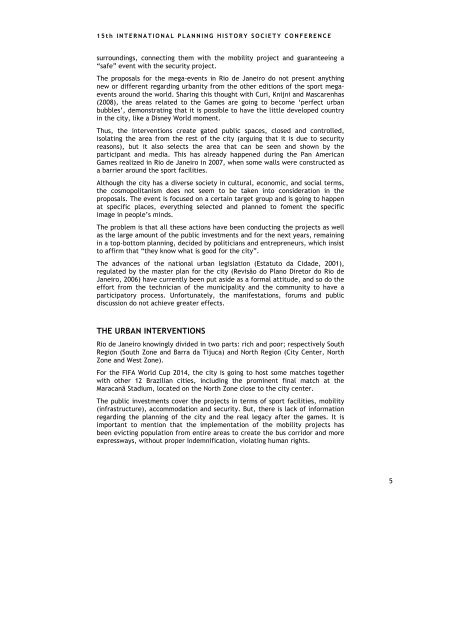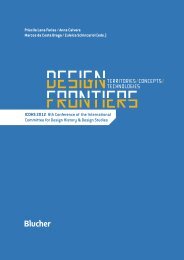MEGA-EVENTS IN RIO DE JANEIRO AND THEIR ... - FAU
MEGA-EVENTS IN RIO DE JANEIRO AND THEIR ... - FAU
MEGA-EVENTS IN RIO DE JANEIRO AND THEIR ... - FAU
Create successful ePaper yourself
Turn your PDF publications into a flip-book with our unique Google optimized e-Paper software.
1 5 t h I N T E R N A T I O N A L P L A N N I N G H I S T O R Y S O C I E T Y C O N F E R E N C E<br />
surroundings, connecting them with the mobility project and guaranteeing a<br />
“safe” event with the security project.<br />
The proposals for the mega-events in Rio de Janeiro do not present anything<br />
new or different regarding urbanity from the other editions of the sport megaevents<br />
around the world. Sharing this thought with Curi, Knijni and Mascarenhas<br />
(2008), the areas related to the Games are going to become ‘perfect urban<br />
bubbles’, demonstrating that it is possible to have the little developed country<br />
in the city, like a Disney World moment.<br />
Thus, the interventions create gated public spaces, closed and controlled,<br />
isolating the area from the rest of the city (arguing that it is due to security<br />
reasons), but it also selects the area that can be seen and shown by the<br />
participant and media. This has already happened during the Pan American<br />
Games realized in Rio de Janeiro in 2007, when some walls were constructed as<br />
a barrier around the sport facilities.<br />
Although the city has a diverse society in cultural, economic, and social terms,<br />
the cosmopolitanism does not seem to be taken into consideration in the<br />
proposals. The event is focused on a certain target group and is going to happen<br />
at specific places, everything selected and planned to foment the specific<br />
image in people’s minds.<br />
The problem is that all these actions have been conducting the projects as well<br />
as the large amount of the public investments and for the next years, remaining<br />
in a top-bottom planning, decided by politicians and entrepreneurs, which insist<br />
to affirm that “they know what is good for the city”.<br />
The advances of the national urban legislation (Estatuto da Cidade, 2001),<br />
regulated by the master plan for the city (Revisão do Plano Diretor do Rio de<br />
Janeiro, 2006) have currently been put aside as a formal attitude, and so do the<br />
effort from the technician of the municipality and the community to have a<br />
participatory process. Unfortunately, the manifestations, forums and public<br />
discussion do not achieve greater effects.<br />
THE URBAN <strong>IN</strong>TERVENTIONS<br />
Rio de Janeiro knowingly divided in two parts: rich and poor; respectively South<br />
Region (South Zone and Barra da Tijuca) and North Region (City Center, North<br />
Zone and West Zone).<br />
For the FIFA World Cup 2014, the city is going to host some matches together<br />
with other 12 Brazilian cities, including the prominent final match at the<br />
Maracanã Stadium, located on the North Zone close to the city center.<br />
The public investments cover the projects in terms of sport facilities, mobility<br />
(infrastructure), accommodation and security. But, there is lack of information<br />
regarding the planning of the city and the real legacy after the games. It is<br />
important to mention that the implementation of the mobility projects has<br />
been evicting population from entire areas to create the bus corridor and more<br />
expressways, without proper indemnification, violating human rights.<br />
5

















